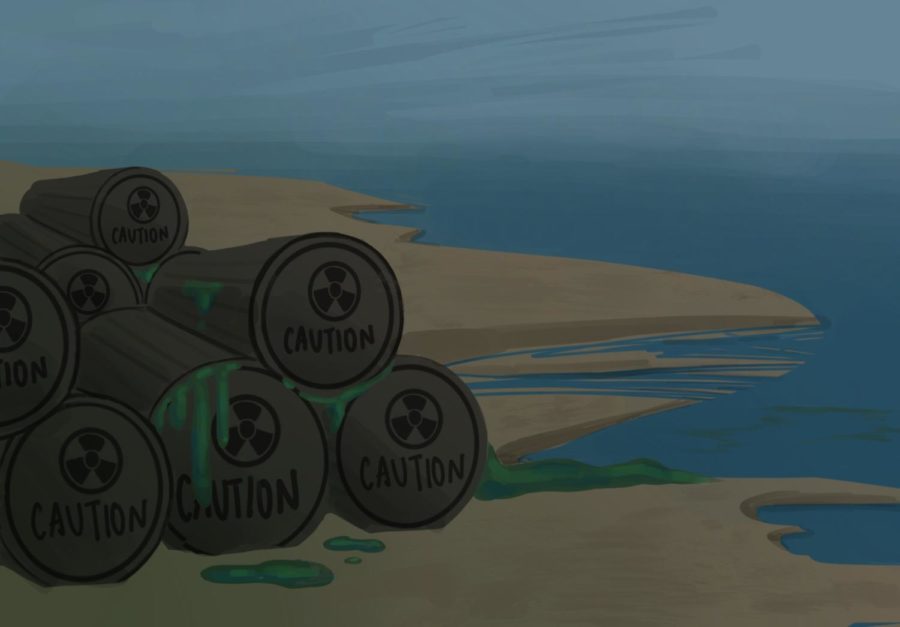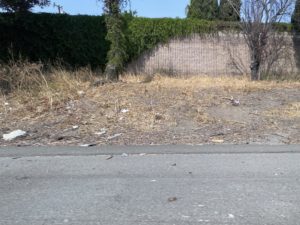Japan’s plan to dump radioactive waste into the Pacific Ocean prioritizes money over environmental concerns
Japan plans to release 1.25 million tons of radiactive water into the Pacific Ocean in 2023.
February 6, 2022
On April 13, 2021, the Japanese government announced that they will allow Tokyo Electric Power Company (TEPCO), the Fukushima Daiichi nuclear power plant operator, to release 1.25 million tons of filtered radioactive waste from the Fukushima Daiichi nuclear explosion into the ocean over 30 years, beginning in 2023. Since the release of this announcement, many of those living in Japan and in countries near it, such as China and South Korea, have been expressing their concern about this plan to release the discharge, as well as worries regarding how it may affect their daily lives in the future.
Following the major earthquake and the tsunami that hit Japan in 2011, the power plants at Fukushima Daiichi in the Fukushima prefecture were severely damaged, causing the meltdown of a few reactors. Radioactive substances were released into the air, causing the people living in the Fukushima prefecture to evacuate. Years later, the Japanese government has approved TEPCO’s careless plan to release the discharge from the power plants, despite the concerns surrounding tritium, carbon-14, cesium, and the health effects that may follow.
On March 11, 2011, the Tōhoku earthquake hit 130 kilometers east of the coast of Honshu, Japan, with a magnitude of 9.0, resulting in the death of 20,000 people and the shaking being felt as far as Petropavlovsk-Kamchatsky, Russia; Kao-hsiung, Taiwan; and Beijing, China. Soon after, a 50 foot high tsunami soon hit the coasts of Iwate, Fukushima, Ibaraki and Chiba prefectures, causing many towns within the prefectures to be submerged and damaged.
When the earthquake hit, 11 reactors were shut down, and the back up generator for one of the power plants suddenly shut down. As a result, the three of the reactors could not cool down for the first few days, eventually ending up causing the fuel rods (the core of the reactor) to melt down, releasing slight radiation as the melted rods burned through the bottom of the vessels.
With the hydrogen gas in the reactor reacting with the leaked substance, explosions occurred in the first and third reactors. In an attempt to stabilize the reactors and cool it down, the workers pumped seawater and boric acid into it, while then-prime minister Naoto Kan announced a nuclear emergency, and issued an evacuation order for all residents living within a 1.9 mile radius from the power plants at 9 p.m., later expanding it to 6.2 miles. To lower the pressure and temperature build up in the reactors, TEPCO released steam from the reactors one and two, releasing radioactive materials into the air, but it still resulted in reactor units one, two and three exploding from a helium reaction, collapsing the units and harming at least 11 people.
The disaster was first reported as a Level 5 nuclear accident on the International Nuclear Event and Radiological Scale by the Japanese Nuclear and Industrial Safety Agent to the International Atomic Energy Agency, but it was later revised to the highest level, after being reevaluated. This made it one of only two Level 7 disasters in history, the other being the Chernobyl disaster of 1986.
Four years later, it is stated by the Japanese government that TEPCO will have permission to release the treated water (to 1500 Bq/liter) that will supposedly be safe to both the environment and humans into the Pacific Ocean over a span of 30 years. It is estimated that the radiation will reach South Korea within a year of releasing the discharge, the west coast of the United States within three to four years, six years to reach Alaska and the North pole, and seven to eight years to get back to Japan after circulating the Pacific Ocean. Following this statement, those living in Fukushima and in neighboring countries have started to oppose this even more strongly than they have been before because of how quickly it can spread and pollute the ocean. In the Nuclear Power Plant Facebook group managed by Greenpeace Japan, members of the group constantly share news on why it is harmful to release the water into the ocean. Additionally in the Fukushima: a society that protects the lives of children Facebook group, members have been actively discussing how the radiation from the power plants has a correlation to the number of people from Fukushima that have gotten cancer.
Currently, water is still being used to help cool the power plants at the Fukushima Daiichi site. The amount of water that is being used to cool the reactor is constantly being increased daily, and so the amount of contaminated water is being increased by about 140 cubic meters per day. However, it is estimated that the numbers will go down to 100 cubic meters per day by 2025 if the waste is discharged and there is more space made in the storage tanks.
The most worrying substances from the water that will be released is tritium, which is the radioactive isotope of hydrogen, carbon-14, and cesium. According to Shaun Burnie, a nuclear consultant, carbon-14 will take 5730 years to decay to half its original radioactivity. Cesium has a much shorter half life of 30.17 years, which makes it somewhat less dangerous as compared to carbon-14.
“For tritium, the Japanese government argues that tritium has no effects poses no health threats,” said Burnie. “That is not true scientifically, not correct.”
Tritium is the main concern of researchers opposing radioactive waste discharge. It is an internal radionuclide, which means that it sticks inside the body and decays by emitting beta particles inside the body. Dr. Ian Fairlie, who studied radiation and radioactivity since the Chernobyl accident in 1986 with a degree in radiation biology, stated at the Global Online CoP26 Event “No Radioactive Water Dump into the Pacific” that tritium itself is a radioactive substance, and that it is highly exchangeable and mobile in water. Based on this, it is easy to conclude that the radioactive material will quickly contaminate the ocean.
“Tritium has a half life of 12.3 years. And generally, it’s considered around at least 10 half lives is when something remains hazardous,” said Burnie. “So for about 125 years, that radioactivity will move, disperse with ocean currents, but it also will concentrate in marine life.”
Currently, the recommended limit for tritium in the United States is about 740 Bq per liter, but Japan has planned for the tritium to be diluted to a much higher amount, at 1500 Bq/l. Additionally, according to Dr. Fairlie, tritium is a short range beta particle, which is known as a “weak particle,” but beta particles with low ranges are often two to three times more dangerous than particles with strong emitters. From this, it can be seen that the reports by the Japanese government conducted for radioactivity have severely underestimated the possible aftereffects of tritium in the ocean.
To assure those who are worried about the radioactive water, the Japanese government and those who support it have been justifying the action through the reasoning that it is the fastest way for those living in Fukushima to return to their normal lives. By choosing to dump the radioactive material into the ocean, it would be the quickest and most cost-effective method. Additionally, by “filtering” the radioactive material, they claim that it will have minimal effect on the environment, and that there are no unknown or unpredictable after effects.
Yes, simply dumping 1.2 million tons of mildly radioactive waste into the ocean is a much faster and cheaper way to get rid of it rather than storing it for a minimum of 50 year to naturally neutralize it while annually paying ¥100 billion (approximately $870 million). However, while there are methods that both guarantee safety and success in getting rid of it, the problem is that this plan is jeopardizing both the safety of people and the environment. As an example, instead of dumping it, a much safer method is to either store it, or to bury it in the ground. It is clear that the amount of money that would be spent is more of a concern than what may happen as a result of it in the future.
Burnie, who is a senior nuclear specialist for Greenpeace, has been expressing his doubts towards the way the radioactive waste is going to be disposed of due to the dangers the chemicals may pose on the environment. He states that the best way to safely dispose of the radioactive waste is to store it until it is safe enough to be disposed of in a way other than dumping it into the ocean.
“The Japanese government has an alternative, which is that you can store this water and you can process this water. It’s not true that there is no additional storage space, we managed to get the Japanese government’s committee to admit that there was storage space available,” said Burnie. “Basic environmental protection requires that you do your best to protect the environment. And in this case, that means storage. It’s not the cheapest option, which is another reason why the Japanese government wants to go ahead with this plan.”
Kate Lee, a member of the Nuclear Power Plant Facebook group, strongly disapproves of the plan and thinks that the Japanese government hasn’t been providing enough evidence to fully prove that what they’re doing is safe.
“Japan keeps saying that there’s no data acknowledging that releasing this water will affect the environment, but on the other hand, there’s no data saying that it’s safe either,” said Lee. “Do they really need to try in order to find out what really happens? It’s ridiculous how they are undermining what may happen and are simply trying to save money.”
Additionally, the small amount of radioactive cesium-137 that was leaked in 2011 has been spreading in the ocean at an alarming speed. Kyodo News reports that as of November 2021, the radioactive waste traveled to the coast of the United States and has been flowing north past the Bering Sea and the Chukchi Sea. Furthermore, it is estimated that when the cesium-137 is released into the ocean, it will spread across the Pacific Ocean and to the west coast of the US within three to four years, to Alaska, the Chukchi Sea, and the Kamchatka Strait in six years, while it will take seven to eight years for the radioactive material to come back to Japan, and only a year for the waste to spread to North and South Korea.
Though it is stated that there has been no deaths caused by the exposure, many people that either worked with the reactors or those who lived in Fukushima now have been claiming that it has caused a higher number of cancer cases in the area, especially thyroid cancer in children. Exposure to radiation has been proven as a factor that may contribute to thyroid cancer, however the Japanese government has been ignoring these claims, attributing it to the development of newer and better technology to find cancer in children.
In early 2017, a man who worked to clean up the power plant sued TEPCO for getting sick due to radiation exposure for JP¥417,00 (approximately USD$536,000). Five years later, six people who lived in the Fukushima prefecture plan to sue TEPCO for the exposure to radiation causing thyroid cancer on Jan. 27 for ¥616,000,000 (approximately $5.4 million). It is said that the six people were between the ages of six and sixteen at the time, and that four of the six people have gotten surgeries to remove their thyroid glands, while the others went through surgery to treat it. According to the Japan Times, a health survey that was done by the Fukushima Prefectural government showed that 266 people of the 380,000 people that were 18 or younger at the time of the accident either had cancer or showed signs of cancer.
Dr. Fairlie stated how releasing the treated water that has traces of tritium can cause a higher chance of cancer, leukemia and birth defects in the future in all parts of the world because tritium moves around so easily within the ocean to regions around the world. He continues on to say that the reports released by TEPCO and the Japanese government have been underestimating how harmful tritium can be to both humans and the environment if it is dumped into the water.
Additionally, in the Nuclear Power Plant Facebook group, a post with graphs of the number of thyroid cancer patients was uploaded. In the post, it was shown that a cancer information service website, ganjoho.jp, conducted a research on the number of thyroid cancer patients before and after the nuclear accident, and that the number of thyroid cancer in children and adults for both boys and girls increased drastically in the years after the incident. Because exposure to radiation can cause cancer, and the number of people with cancer increased in the region where radioactive steam was released on the day the reactors melted down, it is safe to assume that there is a correlation between the releasing of radioactive materials and increased cancer cases.
Furthermore, it was said that there had been traces of tritium and cesium in the fishes caught off the coast of Japan. One of the rockfishes caught had 2.7 times the amount of cesium allowed in fishes caught for food. A Japanese fisherman also uploaded images of the abnormal situation of how the ocean near Fukushima has drastically changed since the disaster. He has uploaded images of the fishfinder, which showed zero amount of plankton in the ocean, something he deemed as odd because he had fished there for a long time. From this, it is easy to see that the contaminated part has caused some effect into the ocean and the environment, even though only a small amount has been leaked. If TEPCO’s plan is carried out, then a much larger amount of the radioactive water will be released, which may cause an even larger effect on ocean life.
“They say that the tritium and cesium are going to be diluted to a certain level, but we don’t know if it is going to be safe for us in the future because we don’t know what it’s going to be like in the ocean,” said Lee. “As one small fish is eaten by another, then another, then another and we eat it, we don’t know how that’s going to affect us.”
Along with these, it is still unknown what types of aftereffects may occur in the future as a result of dumping filtered radioactive material. Releasing radioactive materials into the ocean can be one of the worst ideas that anyone can have, even if it’s been filtered down, because it would still have some amount of radiation in it. If that spreads in the ocean and around the world, it is hard to say that it will be completely safe with no other effects to nature or to humans.
“The people of Fukushima, the fishing communities in particular, suffered terribly from the earthquake and tsunami and triple reactor meltdown in 2011, and they’ve been trying to rebuild their lives ever since,” said Burnie. “And now the Japanese government is going to make their lives harder again. The majority of people in Fukushima are opposed to the discharges; the fishing unions, the fishing federations in Fukushima and nationally in Japan are against these discharges. Our environment already has been contaminated and cannot be justified.”
With less than a year left before the ocean is polluted with “mild” radioactive waste, it is essential to think again of what is more important and beneficial to not only one country, but to other countries as well. Neutralizing radioactive waste does not change what it used to be — it is still radioactive. The choice to dump radioactive waste into the ocean, where many resources exist that we rely on, instead of safely storing it and naturally neutralizing it, clearly highlights the problems that it will cause for us in the future. Now, with such little time left, we must reconsider the question: Is dumping radioactive waste into the ocean the right option?







